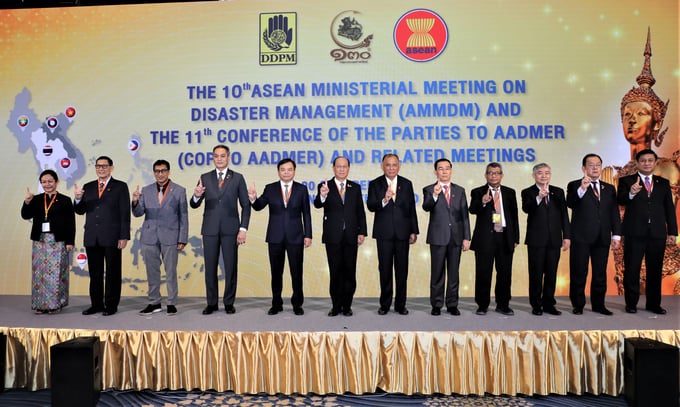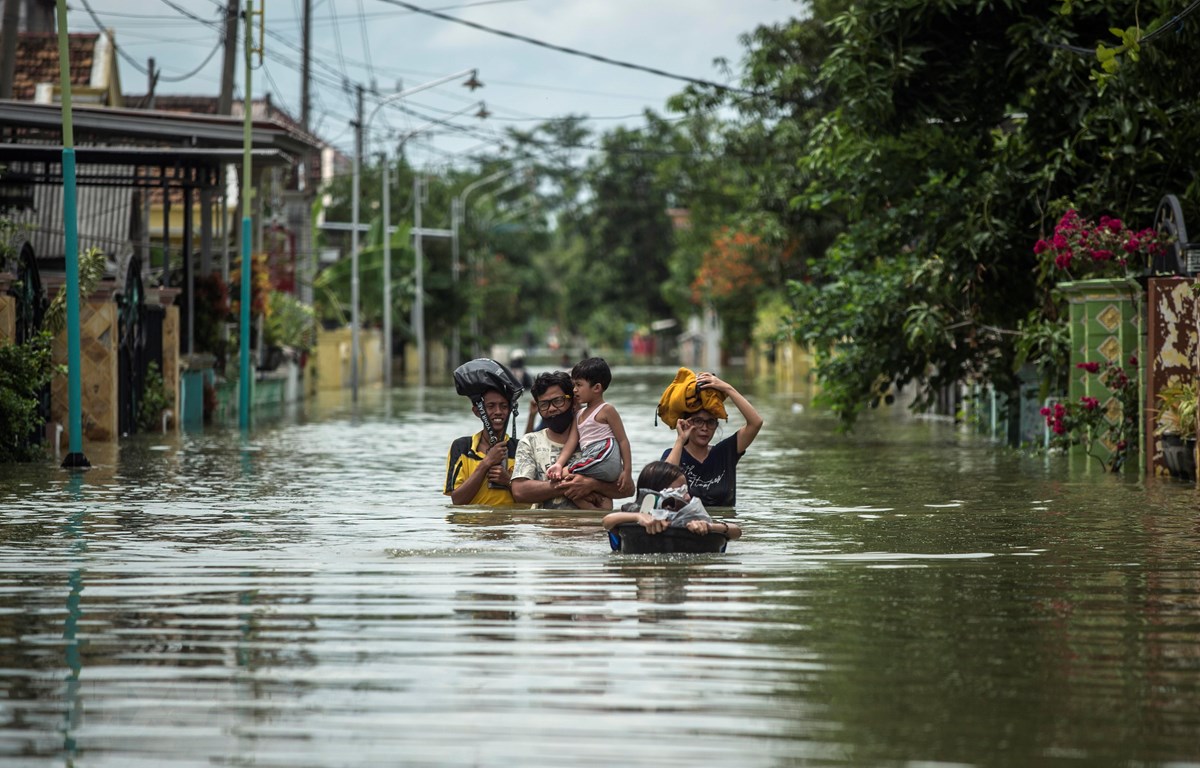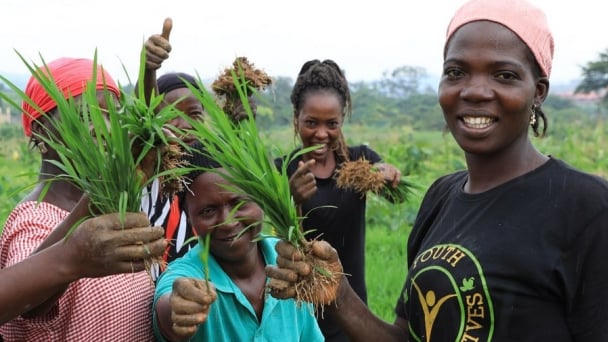May 15, 2025 | 10:12 GMT +7
May 15, 2025 | 10:12 GMT +7
Hotline: 0913.378.918
May 15, 2025 | 10:12 GMT +7
Hotline: 0913.378.918

Participants of the 10th ASEAN Ministerial Meeting on Disaster Management in Bangkok, Thailand. Photo: PH.
Vietnam has been an active and highly respected member of ASEAN. Namely, ASEAN cooperation in Disaster Management is one of its significant socio-cultural pillars. The Ministry of Agriculture and Rural Development is currently the focal point for various activities under the ASEAN Agreement on Disaster Management and Emergency Response and the Agreement on the Establishment of the ASEAN Coordinating Centre for Humanitarian Assistance on disaster management (AHA Center).
It is Vietnam's obligation to host a major forum on disaster management in the ASEAN region. This task will also allow Vietnam to enhance its role, prestige and positionrole, reputation, and status in ASEAN as well as the global stage. Furthermore, the forum enlists the support of the international community for Vietnam's disaster prevention and control, which will contribute to building a resilient ASEAN community.
As the Chair of ASEAN Committee on Disaster Management, Vietnam has been tasked with implementing the Agreement on Disaster Management and Emergency Response. Accordingly, the Ministry of Agriculture and Rural Development will assume the Chairmanship of 11th ASEAN Ministerial Meeting on Disaster Management, the 12th meeting between the Parties to the Agreement on Disaster Management and Emergency Response, the ASEAN Ministerial Meeting on Disaster Management + Korea, the ASEAN Ministerial Meeting on Disaster Management + China, the ASEAN Ministerial Meeting on Disaster Management + Japan, the ASEAN Committee on Disaster Management, the ASEAN Committee on Disaster Management + Korea, ASEAN Committee on Disaster Management + China, ASEAN Committee on Disaster Management + Japan and the AHA Center Administration.
The main contents of meetings, conferences and activities during Vietnam's chairmanship in 2023 will focus on evaluating the progress of the Agreement on Disaster Management and Emergency Response Work from 2021 to 2025; adjusting the contribution to the AHA Center Fund, operating the AHA Center to support ASEAN Member States in disaster response; mobilizing resources to implement the Agreement on Disaster Management and Emergency Response; coordinating the response to major disasters in the region as Chair of the ASEAN Committee on Disaster Management in 2023; bolstering cooperation with China, Japan and Korea.
The Ministry of Agriculture and Rural Development of Vietnam will coordinate with the ASEAN Secretariat, AHA Center and ASEAN member states to organize ASEAN Ministerial Meetings as well as multiple technical meetings on disaster management in 2023 in Vietnam. These events will support the implementation of the Agreement on Disaster Management and Emergency Response.

The ASEAN region suffers an average annual economic loss of 86.5 billion USD to natural disasters. Photo: TL.
Southeast Asia is one of the most disaster-prone regions in the world. According to the United Nations Economic and Social Commission for Asia and the Pacific, natural disasters including floods, storms, heatwaves, droughts, earthquakes and tsunamis have caused countries in the region to suffer an average annual economic loss of at least 86.5 billion USD.
According to statistics between 2012 and 2020, nearly 3,000 natural disasters have occurred in Southeast Asia, including several large-scale storms such as Typhoon Bopha in the Philippines in 2012; Typhoon Haiyan in the Philippines in 2013; Central Sulawesi earthquake and tsunami in Indonesia in 2018; Typhoon Mangkhut in the Philippines in 2018 and Typhoon Damrey in Vietnam in 2017 among many others.
As one of the fastest growing regions in the world with rapid urbanization, population growth, the degraded natural environment degradation along with climate change have exposed Southeast Asia to natural disasters that are increasingly severe in intensity and frequency.
Consequently, cooperation between ASEAN member states in disaster management has become a prominent highlight in multi-sectoral cooperation and commitments in the ASEAN region as well as with stakeholders outside the region. Disaster risk reduction is also one of ASEAN's top priorities to achieve the goals of the Sendai Framework for Disaster Risk Reduction and the 2030 Sustainable Development Goals.
In 2023, Vietnam aims to improve the quality of natural disaster warnings and forecasts, with a focus on storms, tropical depressions, heavy rains, floods, flash floods, landslides, heat waves, droughts, water shortages, saltwater intrusion, etc. Vietnam will also focus on quantitative heavy rain forecast, flash floods and landslides warnings in service of natural disaster prevention and control. Furthermore, the government will promote the study on impact-based forecasting and risk-based warning; strengthen communication with communities across the country with regards to tropical depressions, storms, heavy rains, flash floods, landslides, droughts, saltwater intrusion and other natural disasters.
Translated by Nguyen Hai Long

(VAN) Data from 10,000 farming households will help professionalize production organization and support the implementation of the One Million Hectares Program for High-Quality, Low-Emission Rice Cultivation.

(VAN) FAO Director-General QU Dongyu marks International Day of Plant Health at NENA conference.

(VAN) Deputy Minister of Agriculture and Environment Hoang Trung affirmed that floriculture and ornamental plants are a growing industry that receives significant global attention.

(VAN) The three staple crops dominating modern diets – corn, rice and wheat – are familiar to Americans. However, fourth place is held by a dark horse: cassava.
/2025/05/10/4037-3-223011_495.jpg)
(VAN) Remote sensing technology is becoming an indispensable tool in monitoring resources, developing modern agriculture, and protecting the environment in Vietnam.

(VAN) The trash bag used on fishing vessels can withstand rough sea conditions, including level 8 to level 10 winds and waves. Notably, it can be hung anywhere on the boat.

(VAN) African leaders launched the Kampala Declaration on Building Resilient and Sustainable Agrifood Systems in Africa, marking a bold step toward transforming the continent's agriculture.